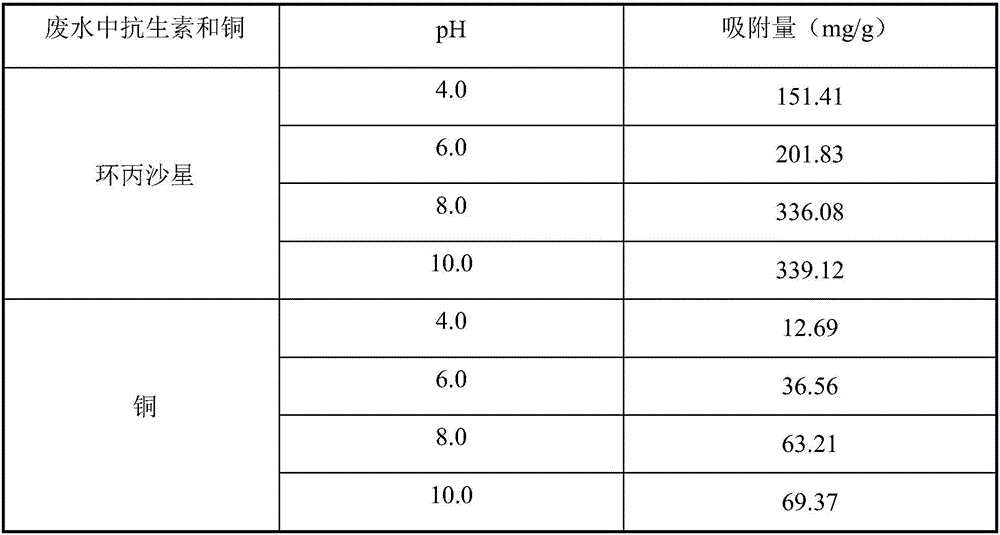Method for treating antibiotic and heavy metal combined pollution water by using modified graphene oxide
A compound pollution and antibiotic technology, applied in chemical instruments and methods, alkali metal compounds, water pollutants, etc., can solve the problems of not being able to remove heavy metals and antibiotics at the same time, reducing the concentration of ciprofloxacin and copper, and high cost of adsorbents, etc. Achieve the effects of easy recycling, wide source of raw materials, and non-toxic effect
- Summary
- Abstract
- Description
- Claims
- Application Information
AI Technical Summary
Problems solved by technology
Method used
Image
Examples
Embodiment 1
[0025] 6g graphite powder, 5gK 2 S 2 o 8 , 5gP 2 o 5 Add to 24 mL of 98% HO 2 SO 4 in 80°C for 4.5h. Cool to room temperature, add 1L ultrapure water to dilute and leave overnight for 12h. The mixture was filtered and rinsed with deionized water to neutralize residual acid. Oven drying at 60°C to obtain pre-oxidized graphite; add pre-oxidized graphite to 240mL98%H 2 SO 4 In solution (0°C). Add 5g NaNO while stirring 3 , 30gKMnO 4 React for 4 hours under ice bath condition. Then the temperature was raised to 35°C for 2 hours, 500 mL of ultrapure water was added and reacted for 1 hour at 98°C, and then 1L of ultrapure water and 40 mL of 30% H were added at room temperature. 2 o 2 , continue to react for two hours. The obtained mixture was washed with 10% HCl, then washed with a large amount of water to neutrality, added water to constant volume, and ultrasonically dispersed for 2 hours to obtain a graphene oxide aqueous suspension; 100mL of 0.1mol / L ferric chlorid...
Embodiment 2
[0028] In the mixed solution of ciprofloxacin and copper with different pH values, add the above-mentioned magnetic graphene oxide modified with nitrilotriacetic acid, comprising the following steps:
[0029] Add 0.0033g of nitrilotriacetic acid-modified magnetic graphene oxide composite material into 25mL of a mixed solution of 50mg / L ciprofloxacin and 10mg / L copper, adjust the pH to 4.0-10.0, and perform oscillation adsorption in a water bath constant temperature oscillator at 25°C After 14 hours, the adsorbent was separated from the waste water by a magnet, and the content of unadsorbed ciprofloxacin in the waste water was measured at 276nm with an ultraviolet spectrophotometer, and the unadsorbed copper in the waste water was measured with an atomic absorption spectrometer. content, the calculated adsorption results are shown in Table 1:
[0030] Table 1: Adsorption data of ciprofloxacin and copper by adsorbents under different pH conditions
[0031]
[0032] It can be...
Embodiment 3
[0034] Add copper solutions of different concentrations to the ciprofloxacin solution, and then add the above-mentioned nitrilotriacetic acid-modified magnetic graphene oxide, comprising the following steps:
[0035] Add 0-4mg / L copper ions to the ciprofloxacin solution with an initial concentration of 50mg / L, add 0.0033g nitrilotriacetic acid-modified magnetic graphene oxide composite material, and carry out oscillating adsorption reaction in a constant temperature oscillator in a water bath at 25°C. After 14 hours, the adsorbent was separated from waste water by magnet, and the content of unadsorbed ciprofloxacin in waste water was measured at 276nm with a UV spectrophotometer, and the calculated adsorption amount results are shown in table 2:
[0036] Table 2: Adsorption data of ciprofloxacin by adsorbents at different copper concentrations
[0037] Copper concentration (mg / L) 0 0.01 0.1 0.5 1 2 4 Ciprofloxacin adsorption capacity (mg / g) 236.10 222.9...
PUM
 Login to View More
Login to View More Abstract
Description
Claims
Application Information
 Login to View More
Login to View More - R&D
- Intellectual Property
- Life Sciences
- Materials
- Tech Scout
- Unparalleled Data Quality
- Higher Quality Content
- 60% Fewer Hallucinations
Browse by: Latest US Patents, China's latest patents, Technical Efficacy Thesaurus, Application Domain, Technology Topic, Popular Technical Reports.
© 2025 PatSnap. All rights reserved.Legal|Privacy policy|Modern Slavery Act Transparency Statement|Sitemap|About US| Contact US: help@patsnap.com



